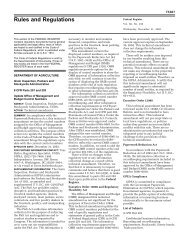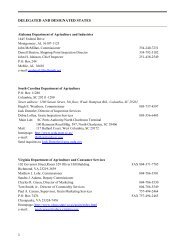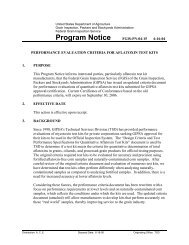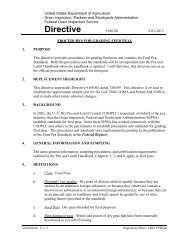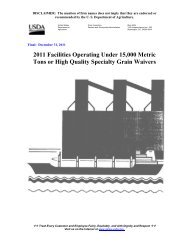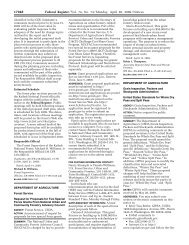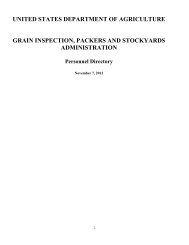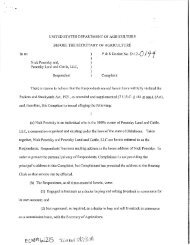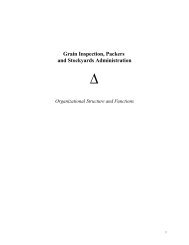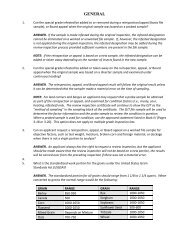Assessment of the Cattle and Hog Industries Calendar Year 2000
Assessment of the Cattle and Hog Industries Calendar Year 2000
Assessment of the Cattle and Hog Industries Calendar Year 2000
Create successful ePaper yourself
Turn your PDF publications into a flip-book with our unique Google optimized e-Paper software.
lock in <strong>the</strong> price. The locked price is determined by applying <strong>the</strong> basis to <strong>the</strong> futures<br />
market price for that date. The packer <strong>and</strong> feeder agree on a delivery date <strong>and</strong> time.<br />
P&SP reports on <strong>the</strong> volume <strong>of</strong> cattle that packers report <strong>the</strong>y have procured under<br />
forward contracts <strong>and</strong> market agreements. Between 1988 <strong>and</strong> 1998, <strong>the</strong> latest data<br />
available, <strong>the</strong> percentage <strong>of</strong> cattle <strong>the</strong> 15 largest packers reported procuring through<br />
marketing agreements <strong>and</strong> forward contracts ranged between 13 percent <strong>and</strong> 19 percent,<br />
with no upward or downward trend over <strong>the</strong> period. 50<br />
Packer Feeding–Packers slaughter some cattle that <strong>the</strong>y own <strong>and</strong> feed <strong>the</strong>mselves, ei<strong>the</strong>r<br />
in <strong>the</strong>ir feedlots or in custom feedlots. In some instances, <strong>the</strong> feedlot may be owned by a<br />
subsidiary <strong>of</strong> <strong>the</strong> packing firm, or by a subsidiary <strong>of</strong> a separate parent company <strong>of</strong> <strong>the</strong><br />
packer. In some instances, packers may enter into joint ventures, sharing ownership <strong>of</strong><br />
cattle with individuals or with feedlots where <strong>the</strong> cattle are fed. A joint venture is a pr<strong>of</strong>it<br />
sharing agreement in which <strong>the</strong> feeder <strong>and</strong> packer share <strong>the</strong> costs <strong>and</strong> revenues. When<br />
packer-owned cattle are ready for slaughter, <strong>the</strong> feedlot manager notifies <strong>the</strong> packer <strong>of</strong> <strong>the</strong><br />
number <strong>of</strong> head <strong>and</strong> <strong>the</strong> week <strong>of</strong> delivery <strong>and</strong> <strong>the</strong> packer schedules <strong>the</strong> delivery day.<br />
Typically, feedlot managers will notify <strong>the</strong> packer when <strong>the</strong> cattle have reached <strong>the</strong><br />
desired weight <strong>and</strong> degree <strong>of</strong> finish, <strong>and</strong> <strong>the</strong> packer has discretion in scheduling delivery<br />
for slaughter. Based on data reported to P&SP by <strong>the</strong> packers, packer-fed cattle as a<br />
percentage <strong>of</strong> slaughter declined from 4.7 percent in 1988 to 3.5 percent in 1998. 51<br />
Captive Supplies–Producers <strong>and</strong> o<strong>the</strong>rs have differing concepts <strong>of</strong> what constitutes<br />
captive supplies. Some, including P&SP, define captive supplies as cattle that are owned<br />
by or under contract to a packer more than 14 days before <strong>the</strong> animals are ready for<br />
slaughter. P&SP’s definition includes cattle procured through marketing agreements,<br />
forward contracts, <strong>and</strong> packer feeding arrangements. Some market participants define<br />
captive supplies to include all transactions in which price is based on a plant average<br />
price, while o<strong>the</strong>rs define as captive supplies all non-spot market transactions. Some<br />
limit <strong>the</strong> definition <strong>of</strong> captive supplies to cattle committed to a packer for any period <strong>of</strong><br />
time, while o<strong>the</strong>rs require a set amount <strong>of</strong> time, which can be more or less than <strong>the</strong> 14<br />
days used by P&SP. P&SP is undertaking a Congressionally-m<strong>and</strong>ated study <strong>of</strong> <strong>the</strong><br />
captive supplies issue. 52<br />
Fed <strong>Cattle</strong> Pricing Methods<br />
Pricing methods refer to <strong>the</strong> method used to determine <strong>the</strong> price paid for a specific lot <strong>of</strong><br />
cattle. Examples <strong>of</strong> pricing methods include liveweight, in-<strong>the</strong>-beef, grade <strong>and</strong> yield, <strong>and</strong><br />
formula. The same price may be paid for all animals in a lot (lot-average pricing) or<br />
different prices may be paid for each animal (carcass-merit or value-based pricing).<br />
Lot-Average Pricing<br />
50 Packers <strong>and</strong> Stockyards Programs, Packers <strong>and</strong> Stockyards Statistical Report, 1998 Reporting <strong>Year</strong>, GIPSA SR-00-1, GIPSA-<br />
USDA, July <strong>2000</strong>.<br />
51 Ibid.<br />
52 Conference Report 106-948, 106 th Congress, 2d Session, to accompany H.R. 4461, October 6, <strong>2000</strong>.<br />
14



